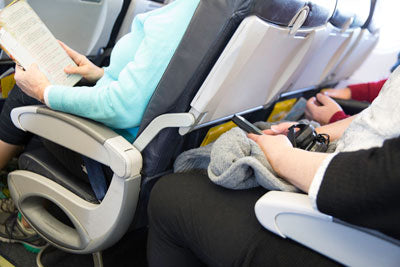Top Calf Compression Sleeves for Traveling
If you’re searching for the Best Compression Calf Sleeves For Travel, you’re likely tired of dealing with swollen legs, stiffness, or discomfort during long flights and road trips. Good news! high-quality calf compression sleeves can make your travel experience significantly more comfortable. In this guide, you’ll discover exactly how they work, what benefits they bring, and which options, especially from Doc Miller compression socks are worth considering for smoother, healthier, and easier travelling.
What Are Compression Calf Sleeves?
Compression calf sleeves are fabric tubes designed to wrap around your calves and apply gentle, graduated pressure. Unlike full compression socks, they leave your feet exposed while still providing circulation support to your lower legs.
Compression calf sleeves help boost blood flow, reduce swelling, and prevent leg fatigue, all essential when you spend hours sitting on a plane, train, or car.
They’re popular among runners, athletes, and now frequent travelers thanks to benefits like:
-
Better circulation
-
Reduced muscle soreness
-
Lower risk of swelling and mild leg discomfort
-
Lightweight portability, perfect for packing
Top Compression Calf Sleeves for Travel
Below are top picks chosen for comfort, effectiveness, and durability, ideal calf compression sleeves for travelling long distances. Doc Miller Sports products are highlighted for their proven performance and traveler-friendly features.
1. Doc Miller Premium Calf Compression Sleeves
Key Features:
-
Graduated 20–30 mmHg compression
-
Breathable, durable medical-grade fabric
-
Snug, non-slip fit
-
Multiple sizes and colors
Why It’s Ideal for Travel:
Because travel often means hours of sitting still, these sleeves help maintain blood flow and prevent heavy-leg sensations. They’re lightweight, easy to pack, and perfect for long flights.
Pros:
-
Strong medical-grade compression
-
Soft yet supportive
-
Smooth, comfortable feel
Cons:
-
Medium-tight feel may be intense for first-time users
2. Doc Miller Advanced Support Sleeves
Key Features:
-
Higher-compression option for extra swelling control
-
Stretch-flex design
-
Ideal for long-haul flights
Why It’s Ideal for Travel:
Perfect for travelers prone to swelling or those with long itineraries. Offers firmer support without feeling restrictive.
Pros:
-
Enhanced compression for long travel days
-
Excellent durability
Cons:
-
Not recommended for casual, short trips
3. Copper-Infused Travel Calf Sleeves (General Market Pick)
Key Features:
-
Light compression
-
Odor-resistant material
-
Breathable and soft
Why It’s Ideal for Travel:
A gentle option for travelers who want comfort over strong compression.
Pros:
-
Great for beginners
-
Soft and breathable
Cons:
-
Not as supportive as medical-grade sleeves
How Do Compression Calf Sleeves Help During Long Flights and Trips?

They keep your blood moving when you can’t. When traveling, especially by air, your legs stay in the same position for extended hours. This can slow circulation and cause:
-
Swelling (edema)
-
Heavy-feeling legs
-
Mild discomfort or tingling
-
Fatigue or stiffness
Compression calf sleeves counter these effects by:
-
Improving blood return from your legs to your heart
-
Reducing fluid buildup
-
Supporting calf muscles during long periods of inactivity
-
Minimizing soreness after traveling
This makes them a smart investment for anyone who frequently flies or takes long bus/train rides.
What Features Should You Look for in the Best Compression Calf Sleeves for Travel?
To get the most comfort and effectiveness, look for these essential features:
-
Graduated compression (15–30 mmHg): Ensures optimal circulation support.
-
Breathable, moisture-wicking fabric: Keeps legs cool and dry during travel.
-
Durable stitching: Prevents stretching out after multiple uses.
-
Non-slip design: Ensures they stay in place even during movement.
-
Stretch-fit comfort: No pinching, rolling, or cutting into the skin.
-
Travel-friendly weight: Lightweight and easy to pack.
High-quality brands such as Doc Miller Sports, check these boxes consistently.
How To Choose the Right Size and Compression Level for Travelling?

Choosing the correct sleeve makes all the difference. Here’s the straightforward way to do it:
1. Measure Your Calf
Measure the widest part of your calf to ensure proper fit.
2. Match Your Compression Needs
-
15–20 mmHg
Best for casual travelers, first-time users, or short trips -
20–30 mmHg
Ideal for long flights, frequent travelers, or those prone to swelling -
30–40 mmHg
Only if recommended by a medical professional
3. Choose the Right Length
Sleeves should cover from just below the knee to above the ankle.
4. Check the Size Chart
Different brands vary, Doc Miller Sports offers detailed sizing for accuracy.
Only Buy High-Quality Compression Calf Sleeves for Travel
Not all calf sleeves deliver the same level of comfort and support. To ensure you’re getting the Best Compression Calf Sleeves For Travel, choose trusted brands like Doc Miller Sports, known for medical-grade fabric and travel-friendly durability.
Where to Buy High-Quality Calf Compression Sleeves
Online Marketplaces
-
Amazon
-
Brand websites (like Doc Miller Sports)
-
Specialty e-commerce stores for athletic gear
Specialty Sports and Travel Stores
-
Running shops
-
Outdoor gear stores
-
Travel accessory stores
Buying from reputable stores ensur es you get authentic, high-quality, long-lasting sleeves that actually support your legs during travel, not cheap imitations that stretch out after one use.
Frequently Asked Questions
1. What is the best compression level for long-haul travel?
20–30 mmHg is generally recommended for long flights and frequent travelers to maximize swelling reduction.
2. How do sleeves prevent discomfort during sitting?
They improve blood circulation in the lower legs, which prevents fluid buildup (swelling) and heavy-leg sensations caused by long periods of inactivity.
3. Do I need to wear them for the entire trip? Yes, for maximum benefit, wear them throughout the duration of the flight, long bus ride, or time spent sitting down.
Disclaimer: This article should not be construed as medical advice. Please contact a licensed physician for a proper diagnosis of your specific case.

